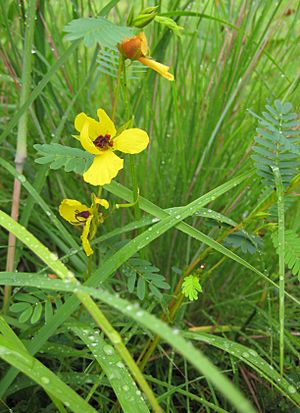Partridge pea facts for kids
Quick facts for kids Partridge pea |
|
|---|---|
 |
|
| Scientific classification | |
| Kingdom: | |
| (unranked): | |
| (unranked): | |
| (unranked): | |
| Order: | |
| Family: | |
| Genus: |
Chamaecrista
|
| Species: |
C. fasciculata
|
| Binomial name | |
| Chamaecrista fasciculata (Michx.) Greene
|
|
| Synonyms | |
|
|
The partridge pea (scientific name: Chamaecrista fasciculata) is a beautiful plant with bright yellow flowers. It's a type of legume, like beans or peas, and grows naturally in most of the eastern United States. This plant usually grows to about 0.5 meters (about 1.5 feet) tall. It blooms from early summer until the first cold weather arrives, as long as it gets enough rain.
Partridge pea flowers are special because they have both male and female parts. This means they can produce both pollen and seeds. Only bees pollinate these flowers, helping the plant make new seeds.
The flowers have two kinds of yellow parts called anthers. Some anthers make pollen for reproduction, and others make pollen that bees eat. The flowers don't produce nectar, which is a sweet liquid many other flowers offer. However, the plant has tiny orange glands on its leaf stems that produce nectar. These glands attract other insects like sweat bees, flies, wasps, and ants.
Partridge pea grows well in areas that have recently been burned. It helps cover the ground quickly, stopping the soil from washing away (erosion). This also allows other plants to grow later. People sometimes plant partridge pea as an ornamental plant in gardens or to help bees make honey.
What the Partridge Pea Looks Like
The leaves of the partridge pea are made up of 10 to 15 pairs of small, thin leaflets. These leaflets feel a bit delicate if you touch them.
The bright yellow flowers are about 1 inch (2.5 cm) wide. They usually grow in groups of 2 to 4 flowers on the stem. These flowers typically bloom from July to September. After the flowers, the plant produces a straight, narrow pod that is about 1.5 to 2.5 inches (4 to 6 cm) long. When the pod dries, it splits open along two sides, and the sides twist to shoot the seeds far away from the parent plant.
Wildlife and the Partridge Pea
The seeds of the partridge pea are a very important food source for many animals, especially birds. They are a major food for northern bobwhite and other quail species. This is because the seeds stay good to eat all through the winter and early spring. Studies in Alabama showed that partridge pea seeds were one of the most important foods for bobwhite quail in fall and winter.
Partridge pea seeds are full of good nutrients like phosphorus and protein. They are also easy for animals to digest. Besides quail, other birds like the greater prairie-chicken, lesser prairie-chicken, ring-necked pheasant, and mallard also eat these seeds. Small mammals like field mice and other grassland birds also enjoy them.
When partridge pea grows in thick groups, it creates a lot of plant material and stalks. This provides great cover and shelter for upland game birds, small mammals, small non-game birds, and waterfowl.
The partridge pea is also known as an important plant for honey production. It often grows in places where there aren't many other plants that bees can get honey from. As mentioned before, the flowers themselves don't have nectar, but the small orange glands at the base of each leaf produce it. Ants often visit these glands to collect the nectar.
The common sulfur butterfly lays its eggs on the leaves of the partridge pea. When the eggs hatch, the young caterpillars eat the leaves as their food.
Images for kids
See also
 In Spanish: Chamaecrista fasciculata para niños
In Spanish: Chamaecrista fasciculata para niños


